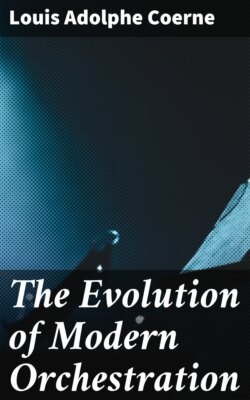Читать книгу The Evolution of Modern Orchestration - Louis Adolphe Coerne - Страница 13
II.
ОглавлениеThe second and more powerful incentive that instrumentation received was from monody, in connection with which its function as accompaniment in simplified form was demonstrated. The fons et origo of declamatory recitative are, of course, to be traced to the attempted reforms of the Florentine camerata. Monody was the cradle of opera and oratorio, and became in turn the foster child of her progeny. Now these histrionic roots were diversified and far reaching.
In the first place, during the two centuries preceding the era under discussion, the miracle plays and representations of similar purport had had recourse to musical support, though of a nature disjointed and irrelevant.
Secondly, the efforts of the troubadours, minstrels, and minnesingers embodied solo-singing to instrumental accompaniment, and contained elements of the dramatic.
Lastly, a newly awakened veneration for everything pertaining to classic Greece revealed the nobility of her drama. This was the causa vera to be espoused! And the evolution of this renaissance, which reached a climax in 1600, must be traced to the history of the Medici.
Toward the close of the fifteenth century, when three generations of that family had brought Florence to the height of her glory, art had received a new impulse under the fostering care of Lorenzo. Moreover, science had acquired the doctrines of the Greek scholars fleeing from Turkish oppression. And the brief interim of asceticism under the sway of the Dominican monk, Savanarola, was followed by the restoration to power of the Medici. A non-clerical influence in all matters pertaining to art made itself felt, and the founding of the Platonic Academy by Cosimo the Great added fuel to the already existing predilection for the drama as exploited by the Ancients.
Hence the aim of the amateur poet and composer, Bardi, and his coterie was to produce a drama which should faithfully conform to the purity and idealism of classic models. And they sought diligently for a clue to original renditions of Attic tragedy, the Dorian choral lyrics, the song-lyrics of Anacreon, Sappho. But their conception thereof was based on a fallacy, so that were one to judge the fruits of their labors solely for their intrinsic value, the verdict would be disappointing.
On the other hand, the step they took was a gigantic one forward in its revolutionary after-results. For the quintessence of recitative and lyrical solo was contained in Galilei's and Caccini's declamatory recitatives with accompaniment of lute or viol; in Peri's and Caccini's "Dafne" and "Euridice"—the first genuine music dramas in the monodic style; in Cavalieri's allegory or incipient oratorio "L'Anima e Corpo." All these attempts were infinitely more expressive and effective than the sombre selections with which A. Gabrieli and Merulo had been wont to enliven festive secular occasions. Bardi and Corsi, in the face of conservatism and skepticism, had sought to reinstate the principles founded upon the Greek Dithyramb. Inspired by the enthusiasm of these two amateurs, the professionals, Peri and Cavalieri, succeeded simultaneously in discovering two rational operatic designs, capable of sequent dramatic treatment.
Finally, the very nature of the monodic principle was inseparable from instrumental accompaniment, and the primary causes that led to monody, namely, expression and dramatic effect, would in themselves insist upon a keener appreciation for instrumental combination as to selection, distribution of parts, dynamics, color-scheme. This is borne out to a limited extent in the later works of both Peri and Cavalieri, whose instrumentation, though crude, paved the way for their greater contemporary and eventual successor, Monteverde. Even though the bulk of the figured bass accompaniment was assigned to the harpsichord, "Euridice" called into requisition one viol, three flutes, and a triplet of instruments of the lute variety. Cavalieri made use of practically the same combination, and even recommended that a violin should duplicate the vocal melody throughout.
In contradistinction to these essays at dramatic scoring should be mentioned the instrumentation of Striggio (1535), whose intermezzi or comedies interspersed with music were written in the madrigal style. Nor should the concertante sacred song of Viadana (1564) or the instrumental effects of Gibbons (1583) be overlooked. But Striggio, some thirty odd years before "Euridice" was produced, had not only forestalled but surpassed his immediate successors by the employment of an orchestra of which more than half were stringed instruments; again, seven of these were played with a bow. So that, considering the primitive methods then in use, the constitution of Striggio's orchestra was unique. It consisted of six lutes, seven viols, two gravicembali, six flutes, eight cornetti and tromboni, all of variated types and sizes.
The above enumeration brings to mind the pre-existence of a rather heterogeneous assortment of now partially obsolete instruments with which we are more or less familiar. Therefore, before proceeding from the subject of instrumentation to that of orchestration proper as inaugurated by Monteverde, a review of the structural and mechanical evolution of instruments themselves would seem in place.
